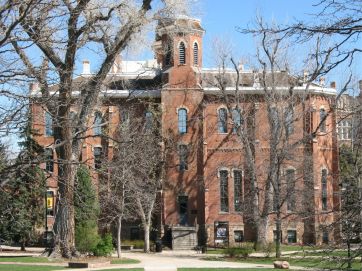In recent months we’ve been looking at the American College and University Presidents Climate Commitment (ACUPCC) and its implications for higher education. The Commitment has been around since 2006 but only recently became a fixture in the news when it began holding universities accountable for the pledges they had made. Suddenly the presidents’ symbolic, fashionable oaths of loyalty have become binding contracts that require large and expensive institutional changes.
We first encountered the ACUPCC in April when we examined the Commitment line by line. It assumes “consensus,” imposes a “social mandate,” and promises to attract “excellent students and faculty...new sources of funding, and...the support of alumni and local communities.” The Commitment includes a list of requirements as steps to “climate neutrality” that must be fulfilled within two years. 648 college and university presidents have signed this pledge (that’s 28 more since April) on behalf of their institutions.
Until recently, the ACUPCC was sponsored by three organizations: the American Association for Sustainability in Higher Education (AASHE), ecoAmerica, and Second Nature. Last month Second Nature assumed primary responsibility for it. Unlike AASHE (which was created by Second Nature), Second Nature was unknown to us and seemed a relatively quiet entity. NAS president Peter Wood took notice of Second Nature and its well-endowed, politically conspicuous founders in a paper he presented on July 23 atop Monte Verità in Switzerland. He wrote, “Second Nature’s multi-million dollar advocacy aimed at the leadership of higher education seems an important part of the story of sustainability’s rise to the position of dominant ideology in the American university—but this is a thread I have not had the opportunity to investigate.”
Not-so-humble Beginnings
Taking the baton from him, I have done some research on Second Nature. It was, as Dr. Wood already observed, founded in Boston in 1993 by Senator John Kerry and Teresa Heinz. They were not yet married but rumors were floating of a budding relationship. According to Wikipedia, the first time the two met following the death of Senator Heinz was at the UN’s 1992 Rio Summit on sustainability.
Perhaps inspiration struck them both at that Summit, and the next year, with the help of a Tufts dean and several others, they launched Second Nature, aiming to “make the principles of sustainability fundamental to every aspect of higher education.”
But let’s think about this a moment. Should the principles of sustainability be fundamental to every aspect of higher education? For the last year and a half NAS has sought to demonstrate the ideological character of the sustainability doctrine and how its agenda on the college campus is much broader than encouraging people to recycle and conserve energy. On the contrary, sustainability in higher education is consistently portrayed as being made up equally of three components: social, economic, and environmental. Sustainability defined this way is a political plan to reshape the world into the progressive vision of utopia.
Advocates of utopian schemes ought to be free of course to state their case, and higher education has long been a venue for the pronouncements of those who have come to believe that they hold the golden key to human happiness and prosperity. But when a movement declares that its agenda is “fundamental to every aspect of higher education,” we need to be on our guard. Every aspect? If that is all we knew about the sustainability movement, it would be more than enough to conclude that its advocates understand little about academic freedom and the need for robust debate.
Second Nature, in its fundraising case statement, readily depicts sustainability as an answer to a universal problem:
Too often, we view health, social, economic, security, environmental, and other major societal issues as separate, competing, and hierarchical, when they are really systemic and interdependent. We do not have environmental problems per se – we have negative environmental consequences of the way we have designed our business, social, economic, and political systems.
Thus we have the famous Venn diagram with three circles, depicting sustainability as the section where social, economic, and environmental solutions overlap. But back to the story. Second Nature remained inconspicuous during its first years, not making a ripple in the news until 1998 when it launched a new website. In the meantime, things were happening.
Treaty in Talloires, Edict in Essex
First, Second Nature takes credit for the Talloires Declaration, the international precursor to the ACUPCC. It was created in 1990 in Talloires, France, at a meeting convened by Tufts University President Jean Mayer. College and university presidents from around the world met together and signed the declaration, pledging that their universities would, among other actions, “Create an Institutional Culture of Sustainability,” “Educate for Environmentally Responsible Citizenship,” and “Foster Environmental Literacy For All.” As of this month, the declaration has been signed by 407 universities in 52 countries. Anthony Cortese, Second Nature’s president, helped craft the convention and the declaration. At the time, he was the Dean of Environmental Programs at Tufts University. More on Cortese later.
Then in 1995 Second Nature held a Workshop on the Principles of Sustainability in Higher Educationin Essex, Massachusetts, along with the President’s Council on Sustainable Development and the Secretariat of University Presidents for a Sustainable Future. The latter formed as a result of the Talloires Declaration and is institutionally affiliated with Tufts University. Out of this meeting came a manifesto called the Essex Report. An article in The Journal of Business Administration and Policy Analysis later called this report “noteworthy” in that “it made a quite ambitious attempt to bridge the economic, social and environmental dimensions of sustainability.”
Pay attention to the Essex Report; it is an important clue to understanding Second Nature’s philosophy. The Essex workshop covers three areas: why higher education must play a leading role in achieving sustainability; how to teach sustainability and what to teach; and how to coax universities to transmute into hubs of sustainability.
At the outset the report endeavors to debunk a myth (similar to Kathleen Kerr’s myth busting at the University of Delaware):
The myth of the value-free university, that knowledge is attained for its own sake, stands in contrast to the reality that special interests always play a greater or lesser role. The myth that higher education is separate from the political, economic and cultural world in which it is embedded, that it is an island unto itself, ignores the reality that higher education is subject to the same natural and societal forces that constrain the activities of all human endeavors; and furthermore, that higher education has an obligation to the well-being of the biosocial community in which it is inextricably embedded.
NAS, apparently, is still living in the myth. We believe that the university should strive for objectivity in its search for knowledge, and that knowledge is attained for its own sake. As propagators of mythology, we also like to recount the story of Argus. In any case, the Essex Report’s attack on the ideal of “the value-free university” stands in a long line of leftist denunciations of liberal learning. Marx’s famous 11th thesis on Feurbach, “Philosophers have only interpreted the world in various ways; the point is to change it," is the fountainhead for this view. The rhetoric of the Essex Report derives more directly from Frankfort School “critical theory,” as passed through the hands of post-modernists in the 1980s. According to this view, attempts to defend the intellectual autonomy of the university are merely masks for the pervasive power of corporate capitalism. Thus, right at its outset, the sustainability movement in higher education was grounded in a Marxist vision of how the university actually works.
The Essex Report asserts that the so-called myths, are “pervasive throughout current institutions of higher education, [and] interfere with the attainment of their mission.” So what is the Essex idea of higher education’s mission? It is “designing a sustainable human future” by revolutionizing the way the world works. This goes far beyond environmental awareness and requires “a paradigm shift toward a systemic perspective which encompasses the complex interdependence of individual, social, cultural, economic and political activities and the biosphere.”
Interpretation
Such a paradigm shift is the equivalent of asking universities to use a non-English language on campus. The translation has begun, and already higher education sounds very different than it did fourteen years ago. The Second Nature folks themselves seem to have a language of their own. Let’s see if we can translate their recommendations for transformation:
Education for Sustainability: Content and Strategies
Moving society on a sustainable path will require major changes in the process and content of higher education.
Translation: We’re starting over with the whole college thing, giving it a one-track mind for sustainability. Why did we ever teach anything else?
Leadership must be provided by university presidents, provosts and deans -- i.e., those who are capable of converging all the academic disciplines and professional schools on large, complex issues.
Translation: We’ll bypass faculty members and anyone else who might try to stand in our way. Top-down authority is the quickest way to control entire institutions.
They must focus their schools' attention on the critical issues of sustainability by speaking out, mobilizing existing resources and acquiring new ones, creating incentives and programs for faculty development, and encouraging relevant teaching and research in all academic domains.
Translation: There’s no place you can hide. Think Calculus is free from sustainability? Music? History? Chinese language? Library science? Medieval studies?Think again.
I don’t want to dwell too much on the Essex Report, but there’s one more paragraph worth taking note of. Remember justainability, the concept that the pursuit of sustainability is all wrapped up in the pursuit of social justice? The Essex workshop may have been the place where this concept was born at least as it is applied to the university. This section is found under “Pedagogical Approaches” to teaching sustainability:
d. Pathways to Justice and Sustainability
A sustainable society is a just society. Many at the workshop felt that this is the overarching principle of environmental justice and sustainable development. In a sense it is redundant to speak about sustainability and justice; the former includes the latter. There may be paths that are not just and fair, but could perhaps be maintained for a limited period of time; but these are not ultimately sustainable paths.
[...]
All aspects of a sustainable society -- economy, culture, institutions/social structure, the ecosystem -- can be viewed from an environmental justice perspective. For example, students must understand the implications for sustainable development of differences between the northern and southern hemispheres, between the "industrially developed" and "developing" worlds; the consequences of free trade agreements; the relationships among women's rights, access to knowledge and sustainability; issues of disproportionate impact; the connection between peace/security and sustainability, and that all these issues are necessarily interdependent.
Here we see some of the specific political, social, and economic positions contained in justainability (i.e., free trade bad, feminism good). In the same section below this paragraph is a list of proposed lessons for college students, including:
Sustainable development with environmental justice redresses past, present, and future maldistribution of resources, privileges and rights of endangered communities, of poor people, and of communities of color.
Maldistribution?
A Man of Vision
The Essex Workshop helped Second Nature lay the framework for its philosophy and goals. That was 1995. The organization then got to work bringing their propositions to colleges and universities, forming an Alliance for Sustainability Through Higher Education with five other organizations, and taking advantage of every speaking and publishing opportunity. President Anthony Cortese is a driving force behind much of these efforts – and the sustainability movement as a whole. The Second Nature case statement praises his “respected ability to clearly articulate the sustainability challenge, to clarify a compelling vision of a healthy, just, and sustainable future, and to enroll change agents to the cause.”
Who is Anthony (Tony) Cortese? He is a man to whom we should pay attention. A Boston native, he received his undergraduate and masters degree from Tufts, and earned a doctor of science degree at Harvard School of Public Health. He was appointed director of the Air Quality Program at the EPA during the Carter presidency, and then served as the Commissioner of the Massachusetts Department of Environmental Protection. He helped found the U.S. chapter of The Natural Step, another sustainability organization. As noted above, he developed the Talloires Declaration and acted as the Dean of Environmental Programs at Tufts.
In 2001, Cortese authored a publication for Second Nature called “Visions of Sustainability in 2050.” While the plural visions evokes “visions of sugar plums danced in their heads,” the Second Nature visions—with saccharinity rivaling sugar plums—are of peace, justice, equity, health, and a cooled-down globe.
Last year at ACPA’s Sustainability Institute Cortese gave a presentation entitled, “The Core Mission of Higher Education: Creating a Thriving, Civil and Sustainable Society.” In it he contends that “We have a civilizational and moral crisis, not merely an environmental one.” Cortese offers a new Venn diagram in which the university models sustainability in four capacities, through education, research, university operations, and the external community.
This spring Allegheny College bestowed an honorary degree on the Second Nature president. Introducing him to receive the award at the commencement ceremony, Allegheny Professor Caryl Waggett called Cortese “an inspirational figure, a man of vision” and “a man who has been ahead of his time.” She said that “His articles, essays, and speeches have helped shape the dialogue on education for sustainability and will inform the work we do for decades.”
Cortese is to the campus sustainability movement as James Hansen, the head of NASA’s Goddard Institute for Space Studies, is to the theory of man-made global warming. Each is a tireless advocate, unhindered by discrepancies in the evidence, and hugely successful in spreading moralistic alarm.
What Else Does Second Nature Do?
And so, founded by a major politician, funded by an heiress, and led by a visionary, Second Nature as an organization has carved out sizeable territory. The ACUPCC has spread like wildfire throughout the nation’s colleges and universities, and will likely come to be viewed as a staple for any competitive institution. Second Nature also has an equivalent of the commitment for churches that wish to make a similar pledge. Perhaps the churches that sign it will be restricted to the Green Bible.
This year two of Second Nature’s leaders, Peter Bardaglio and Andrea Putman, published a book with the National Association of College and University Business Officers (NACUBO) entitled, “Boldly Sustainable:Hope and Opportunity for Higher Education in the Age of Climate Change.” We have ordered the $50 book and expect to report further after its arrival.













